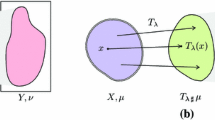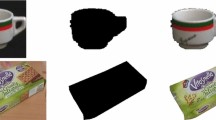Abstract
In this paper, we propose a new variational model to segment an object belonging to a given shape space using the active contour method, a geometric shape prior and the Mumford-Shah functional. The core of our model is an energy functional composed by three complementary terms. The first one is based on a shape model which constrains the active contour to get a shape of interest. The second term detects object boundaries from image gradients. And the third term drives globally the shape prior and the active contour towards a homogeneous intensity region. The segmentation of the object of interest is given by the minimum of our energy functional. This minimum is computed with the calculus of variations and the gradient descent method that provide a system of evolution equations solved with the well-known level set method. We also prove the existence of this minimum in the space of functions with bounded variation. Applications of the proposed model are presented on synthetic and medical images.
Similar content being viewed by others
References
Adalsteinsson, D. and Sethian, J. 1995. A fast level set method for propagating interfaces. Journal of Computational Physics, 118:269–277.
Ambrosio, L. 1989. A compactness theorem for a new class of functions of bounded variation. Bolletino Della Unione Matematica Italiana, VII(4):857–881.
Biswal, B.B. and Hyde, J.S. 1997. Contour-based registration technique to differentiate between task-activated and head motion-induced signal variations in fMRI. Magnetic Resonance in Medecine, 38(3):470–476.
Bresson, X., Vandergheynst, P., and Thiran, J. 2004. A variational model for object segmentation using boundary information, statistical shape prior and the Mumford-Shah functional, ITS technical report 08.04, Signal Processing Institute, Swiss Federal Institute of Technology, Lausanne, Switzerland, http://itswww.epfl.ch.
Bresson, X., Vandergheynst, P., and Thiran, J.P. 2003. A priori information in image segmentation: Energy functional based on shape statistical model and image information. In IEEE International Conference on Image Processing, pp. 425–428.
Caselles, V., Kimmel, R., and Sapiro, G. 1997. Geodesic active contours. International Journal of Computer Vision, 22(1):61–79.
Chan, T.F. and Vese, L.A. 2001. Active contours without edges. IEEE Transactions on Image Processing, 10(2):266–277.
Charpiat, G., Faugeras, O., and Keriven, R. 2003. Shape metrics, warping and statistics. In IEEE International Conference on Image Processing, pp. 627–630.
Chen, Y., Tagare, H.D., Thiruvenkadam, S., Huang, F., Wilson, D., Gopinath, K.S., Briggsand, R.W., and Geiser, E.A. 2002. Using prior shapes in geometric active contours in a variational framework. International Journal of Computer Vision, 50(3):315–328.
Cootes, T. and Taylor, C. 1999. Statistical models of appearance for computer vision. Technical Report, University of Manchester.
Cremers, D., Kohlberger, T., and Schnörr, C. 2002. Nonlinear shape statistics in Mumford-Shah based segmentation. In European Conference on Computer Vision, pp. 93–108.
Cremers, D., Osher, S.J., and Soatto, S. 2004. Kernel density estimation and intrinsic alignment for knowledge-driven segmentation: Teaching level sets to walk. In Annual Pattern Recognition Symposium DAGM, Springer Verlag LNCS, vol. 3157, pp. 36–44.
Cremers, D., Sochen, N., and Schnörr, C. 2003. Towards recognition-based variational segmentation using shape priors and dynamic labeling. In Scale-Space'03, LNCS 2695, pp. 388–400.
Cremers, D., Sochen, N., and Schnörr, C. 2004. Multiphase dynamic labeling for variational recognition-driven image segmentation. In European Conference on Computer Vision, pp. 74–86.
Cremers, D., Tischhäuser, F., Weickert, J., and Schnörr, C. 2002. Diffusion snakes: Introducing statistical shape knowledge into the Mumford-Shah functional. International Journal of Computer Vision, 50(3):295–313.
Davis, L. 1991. Handbook of Genetic Algorithms, Van Nostrand.
Evans, L.C. and Gariepy, R.F. 1992. Measure Theory and Fine Properties of Functions, Studies in advanced Mathematics, CRC Press.
Giusti, E. 1985. Minimal Surfaces and Functions of Bounded Variation. Birkhauser, Basel.
Jehan-Besson, S., Barlaud, M., and Aubert, G. 2003. DREAM2S: Deformable regions driven by an eulerian accurate minimization method for image and video segmentation. International Journal of Computer Vision, 53(1):45–70.
Jonasson, L., Bresson, X., Hagmann, P., Cuisenaire, O., Meuli, R., and Thiran, J.P. 2005. White matter fiber tract segmentation in DT-MRI using geometric flows. Medical Image Analysis, 9(3):223–-236.
Kass, M., Witkin, A., and Terzopoulos, D. 1987. Snakes: active contour models. International Journal of Computer Vision, 321–331.
Kichenassamy, S., Kumar, A., Olver, P., Tannenbaum, A., and Yezzi, A.J. 1996. Conformal curvature flows: From phase transitions to active vision. In Archive for Rational Mechanics and Analysis, vol. 134, pp. 275–301.
Leventon, M. 2000. Statistical models for medical image analysis, Ph.D Thesis.
Leventon, M., Grimson, W., and Faugeras, O. 2000. Statistical shape influence in geodesic active contours. In IEEE International Conference of Computer Vision and Pattern Recognition, pp. 316–323.
Malladi, R., Kimmel, R., Adalsteinsson, D., Sapiro, G., Caselles, V., and Sethian, J.A. 1996. A geometric approach to segmentation and analysis of 3D medical images. In Mathematical Methods in Biomedical Image Analysis Workshop.
Numerical Recipies in C++ and C, Cambridge University Press.
Mumford, D. and Shah, J. 1989. Optimal approximations of piecewise smooth functions and associated variational problems. Communications on Pure and Applied Mathematics, 42:577–685.
Osher, S. and Sethian, J.A. 1988. Fronts propagating with curvature-dependent speed: Algorithms based on Hamilton-Jacobi formulations. Journal of Computational Physics, 79(1):2–49.
Paragios, N. and Deriche, R. 2002. Geodesic active regions: A new framework to deal with frame partition problems in computer vision. Journal of Visual Communication and Image Representation, 13(1–2):249–268.
Paragios, N., Rousson, M., and Ramesh, V. 2003. Non-rigid registration using distance functions. Journal of Computer Vision and Image Understanding, 89(2–3):142–165.
Riklin-Raviv, T., Kiryati, N., and Sochen, N. 2004. Unlevel-sets: Geometry and prior-based segmentation. In European Conference on Computer Vision, pp. 50–61.
Rousson, M., Paragios, N., and Deriche, R. 2004. Implicit active shape models for 3D segmentation in MR imaging. In International Conference on Medical Image Computing and Computer Assisted Intervention (MICCAI), pp. 209–216.
Samson, C., Blanc-Féraud, L., Aubert, G., and Zerubia, J. 2000. A level set model for image classification. International Journal of Computer Vision, 40(3):187–197.
Tsai, A., Wells, W., Tempany, C., Grimson, E., and Willsky, A. 2004. Mutual information in coupled multi-shape model for medical image segmentation. Medical Image Analysis, 8(4):429– 445.
Tsai, A., Yezzi, A., Wells, W., Tempany, C., Tucker, D., Fan, A., Grimson, W.E., and Willsky, A. 2001. Model-based curve evolution techniques for image segmentation. In IEEE International Conference of Computer Vision and Pattern Recognition, pp. 463–468.
Tsai, A., Yezzi, A., Wells, W., Tempany, C., Tucker, D., Fan, A., Grimson, W.E. and Willsky, A. 2003. A shape-based approach to the segmentation of medical imagery using level sets. IEEE Transactions on Medical Imaging, 22(2):137– 154.
Unser, M. 1999. Splines: A perfect fit for signal and image processing. IEEE Signal Processing Magazine, 16(6):22–38.
Vese, L. and Chan, T. 2001. A multiphase level set framework for image segmentation using the Mumford and Shah model, UCLA CAM Report 01-25.
Vese, L.A. and Chan, T.F. 2002. A multiphase level set framework for image segmentation using the Mumford and Shah model. International Journal of Computer Vision, 50(3):271– 293.
Yezzi Jr., A., Kichenassamy, S., Kumar, A., Olver, P.J., and Tannenbaum, A. 1997. A geometric snake model for segmentation of medical imagery. IEEE Transactions on Medical Imaging, 16(2):199–209.
Yezzi, A., Tsai, A., and Willsky, A. 1999. A statistical approach to snakes for bimodal and trimodal imagery. In International Conference of Computer Vision, pp. 898–903.
Zhao, H., Chan, T., Merriman, B., and Osher, S. 1996. A variational level set approach to multiphase motion. Journal of Computational Physics, 127:179–195.
Author information
Authors and Affiliations
Corresponding author
Rights and permissions
About this article
Cite this article
Bresson, X., Vandergheynst, P. & Thiran, JP. A Variational Model for Object Segmentation Using Boundary Information and Shape Prior Driven by the Mumford-Shah Functional. Int J Comput Vision 68, 145–162 (2006). https://doi.org/10.1007/s11263-006-6658-x
Received:
Revised:
Accepted:
Published:
Issue Date:
DOI: https://doi.org/10.1007/s11263-006-6658-x




